The Women's Suffrage Movement
Weighing the Evidence
All documents and text associated with this activity are printed below, followed by a worksheet for student responses.Introduction
Should women be granted the right to vote? Read each document, view each video clip, and assess each picture to determine its purpose. Is it pro- or anti-suffrage? What points does it make in favor of or against granting women the right to vote? Once you have determined whether or not the primary document supports or does not support the passage of the 19th Amendment, place it on the appropriate side of the scale. For example, if you determine that a certain document makes a good point or two of why women should not be allowed to vote, place it on the right-hand side of the level. How far right you place it indicates how strong you believe the evidence is against passing the amendment. Do this for each of the eighteen documents.Name:
Class:
Class:
Worksheet
The Women's Suffrage Movement
Weighing the Evidence
Examine the documents and text included in this activity. Consider how each document does or does not support two opposing interpretations or conclusions. Fill in the topic or interpretations if they are not provided. To show how the documents support the different interpretations, enter the corresponding document number into the boxes near the interpretation. Write your conclusion response in the space provided. Interpretation 1
Women should be granted the right to vote.
Women should be granted the right to vote.
Women's Suffrage
Interpretation 2
Women should not be granted the right to vote.
Women should not be granted the right to vote.
1
Activity Element
Page 1

2
Activity Element
Page 1

3
Activity Element
Page 1

4
Activity Element
Page 1

5
Activity Element
Page 1

6
Activity Element
Page 1

7
Activity Element
Page 1

8
Activity Element
Page 1

9
Activity Element
Page 1

10
Activity Element
Page 1

11
Activity Element
Page 1

12
Activity Element
Page 1

13
Activity Element
Page 1

14
Activity Element
Page 1

15
Activity Element
Page 1

16
Activity Element
Page 1

17
Activity Element
Page 1

Conclusion
The Women's Suffrage Movement
Weighing the Evidence
Based on the evidence , did you conclude that women should or should not have the right to vote? Which two pieces of evidence do you believe presented the strongest argument for a woman's right to vote? Explain. Which two pieces of evidence do you believe presented the strongest argument against a woman's right to vote? Explain. Is there any evidence that either side did not present that could have convinced you to vote their way? Explain.Your Response
Document
Three Marine Corps Women Reservists, Camp Lejeune, North Carolina
10/16/1943
The original caption for this photograph reads: American Indian women too have joined the fighting forces against Germany and Japan. These three are members of the U.S. Marine Corps. They are [left to right] Minnie Spotted Wolf of the Blackfeet, Celia Mix, Potawatomi, and Violet Eastman, Chippewa.
This primary source comes from the Records of the Office of War Information.
National Archives Identifier: 535876
Full Citation: Photograph 208-NS-4350-2; Three Marine Corps Women Reservists, Camp Lejeune, North Carolina; 10/16/1943; Feature Story Photographs , 1942 - ca. 1945; Records of the Office of War Information, ; National Archives at College Park, College Park, MD. [Online Version, https://docsteach.org/documents/document/marine-corps-reservists-camp-lejeune, April 30, 2024]Three Marine Corps Women Reservists, Camp Lejeune, North Carolina
Page 1
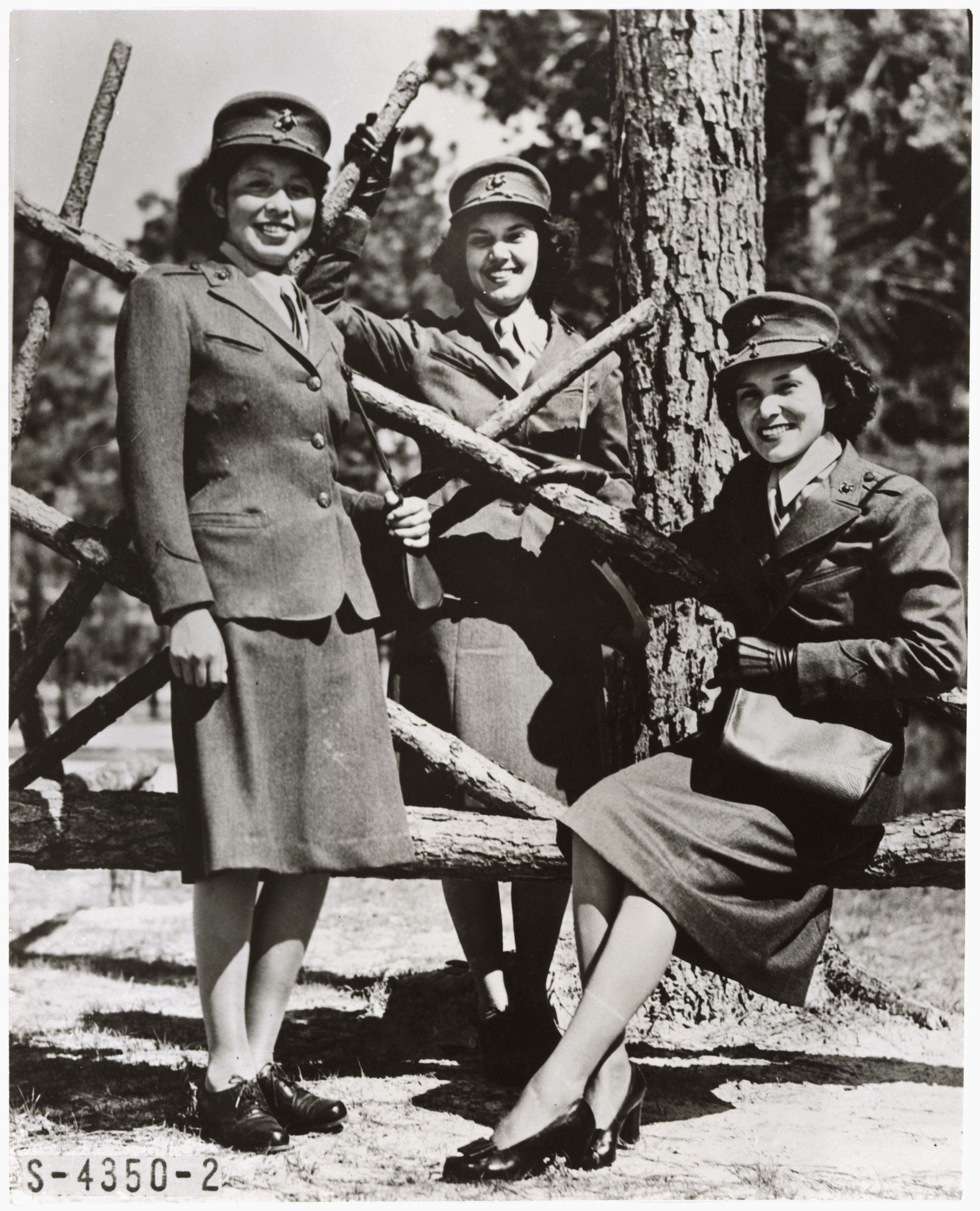
Document
Anti-Suffrage Postcards from Hugh R. Hughes to the Honorable Homer P. Snyder
ca. 1915
Additional details from our exhibits and publications
With this postcard to New York Congressman Homer P. Snyder, Hugh Hughes expressed his opposition to the passage of the 19th Amendment to the Constitution, which would grant women the right to vote. Hughes believed the individual states should set voting requirements rather than the Federal government. Hughes’s plea was ignored as Congress passed a resolution proposing the amendment in 1919, and it was ratified in 1920.
This primary source comes from the Records of the U.S. House of Representatives.
National Archives Identifier: 1633883
Full Citation: Anti-Suffrage Postcards from Hugh R. Hughes to the Honorable Homer P. Snyder; ca. 1915; Records of the U.S. House of Representatives, . [Online Version, https://docsteach.org/documents/document/antisuffrage-postcards-from-hugh-r-hughes-to-the-honorable-homer-p-snyder, April 30, 2024]Anti-Suffrage Postcards from Hugh R. Hughes to the Honorable Homer P. Snyder
Page 1
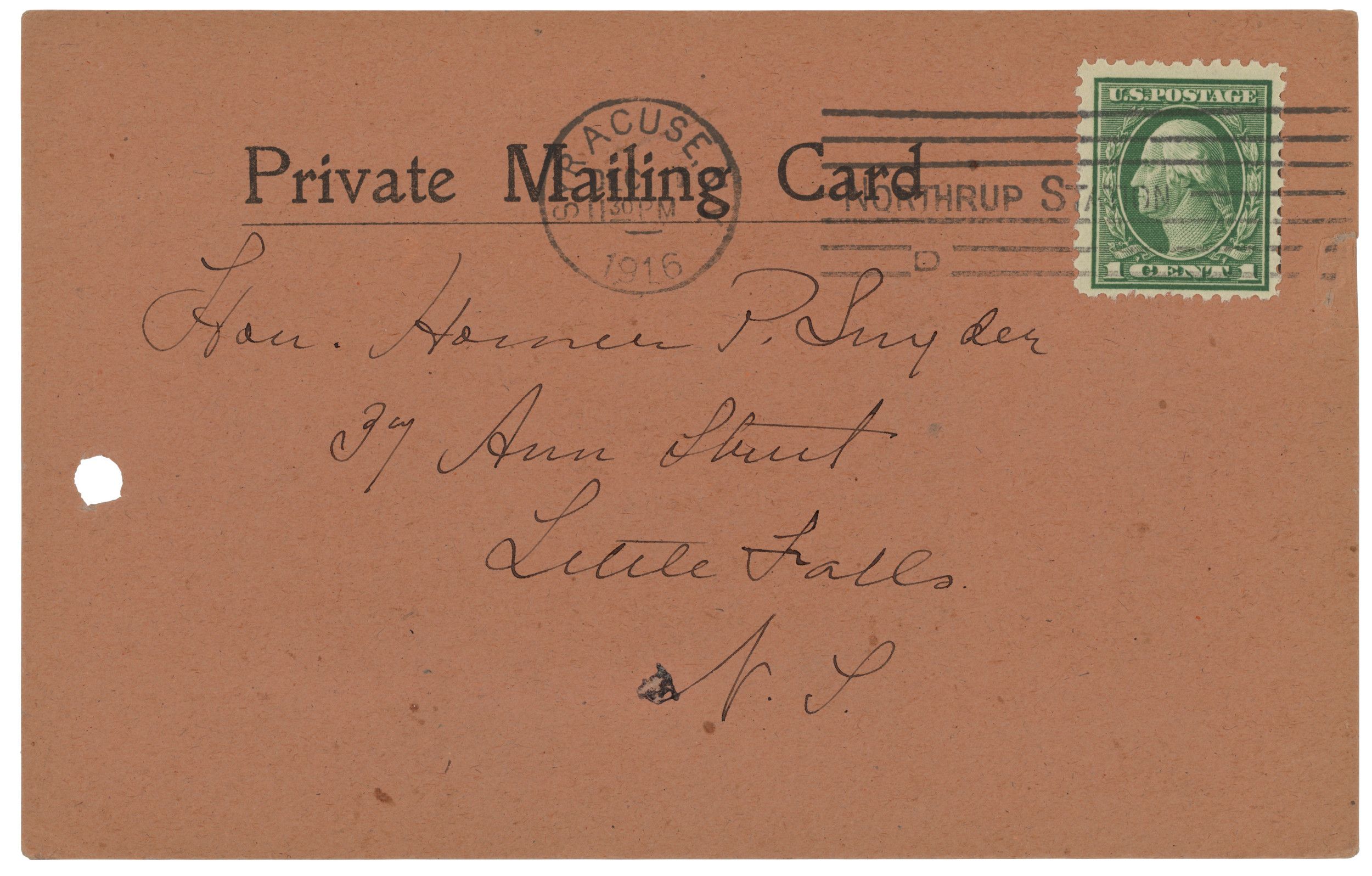
Anti-Suffrage Postcards from Hugh R. Hughes to the Honorable Homer P. Snyder
Page 2

Document
Petition from women of the District of Columbia asking for the passage of the Sumner Civil Rights Bill
1/15/1872
After the ratification of the 14th and 15th Amendments, there was a great divide over how far the Government should go to enforce the rights established by these amendments. The 1875 Civil Rights Bill, first proposed by Senator Charles Sumner in 1870, was an attempt to codify those rights. Senator Sumner was the chief Radical Republican leader during Reconstruction and a vocal proponent of civil rights for freedmen.
Women in the District of Columbia sent this petition urging passage of the Sumner Civil Rights Bill. In eloquent and moving language, they describe the effect the deprivation of equal rights has had on them.
Women in the District of Columbia sent this petition urging passage of the Sumner Civil Rights Bill. In eloquent and moving language, they describe the effect the deprivation of equal rights has had on them.
The bill that passed after much debate and revision in 1875 stated that all American citizens “shall be entitled to the full and equal enjoyment of the accommodations, advantages, facilities, and privileges of inns, public conveyances on land or water, theaters, and other places of public amusement.” Sumner, who died in 1874, did not live to celebrate the bill’s passage or to mourn its ultimate failure. In 1883, the U.S. Supreme Court ruled the Civil Rights Act of 1875 unconstitutional.
Transcript
[Four colored women at [illegible]]To the Honorable the Senate and House of Representatives of the United States in Congress assembled:
We, the undersigned, Mothers, wives & sisters, feeling ourselves aggrieved, & knowing that you have the power to relieve us, appeal to you to pass Sen. Sumner's Supplementary Civil Rights Bill as calculated to meet our case.
We respectfully entreat you to hear our prayer: for we suffer indignities in public conveyances, we are deprived of privilege & advantages to which we are justly entitled in common with others. No principle was violated in the case of our Revolutionary Fathers that is not violated in our case.
Our grievances contain the essence of Slavery. The Slaveholder fed, clothed & housed his slave, poorly it is true & kept him in ignorance that the slave might not aspire to anything better than was contained in his lot. But we feed, clothe & shelter ourselves: we are striving for Education; making every effort to better our condition; & furthermore, we are taxed for the public benefit. We keenly feel all efforts made to keep us down & degrade us. [illegible strikethrough] We are told to aspire to all that is noble & elevating, to
than was contained in his lot. But we feed, clothe & shelter our-selves: we are striving for
Education; making every effort to better our condition; & furthermore, we are taxed for the public benefit. We keenly feel all efforts made to keep us down & degrade us. [struckthrough: not controlling the ballot] We are tied to aspire to all that is noble & elevating, to acquire all the conditions & surroundings of free citizens; and yet, we are subjected to mortifications, insults, & injuries, such as no free women can endure. Not controlling the ballot we are powerless to remedy the evils of which we complain; but though weak in this respect, we are morally strong in influencing our fathers, husbands & brothers; & we feel it a religious duty to use what strength we have in defence of outraged humanity; & in this spirit your petitioners will ever pray.
[left hand column]
Mrs. Louise C. Butler
Mrs. Jes T. Downing
Mrs. S.A.M. Washington
Mrs. Cordelia DeMortie
Mrs. Phillis Tallifano
Mrs. Ransom Parker
Anna Lang
Mrs. E. French
M. J. Williams
[illegible]
Mrs. James A. Harich
[illegible]
Mrs. Mary A. Hackett
Mrs. Elizabeth Johnson
Mrs. [illegible] Wilson
Mrs. [illegible] Jennings
Mrs. [illegible] Baston
Mrs. Annie M. Morrie
'' C.A. Attwell
'' M. M. [illegible]
Mrs. J. S. Marshall
[Right hand column]
Mrs. [illegible]
'' Gufman
Mrs. A. L. Ketchum
M. [illegible]
Mrs. Mary [illegible]
Mrs. Corrie Thompson
Mrs. [illegible]
Mrs. Anna E. Blouden
Mrs. Anna E. Farrell
Rachel E. Bond
M. Betsey Johnson
Ms. Jane Thompson
This primary source comes from the Records of the U.S. Senate.
National Archives Identifier: 306406
Full Citation: Petition from women of the District of Columbia asking for the passage of the Sumner Civil Rights Bill; 1/15/1872; Petitions and Memorials Which Were Tabled Relating to Civil Rights and Political Disabilities; Anson McCook Collection of Presidential Signatures, 1789 - 1975; Records of the U.S. Senate, ; National Archives Building, Washington, DC. [Online Version, https://docsteach.org/documents/document/dc-women-sumner-bill, April 30, 2024]Petition from women of the District of Columbia asking for the passage of the Sumner Civil Rights Bill
Page 1
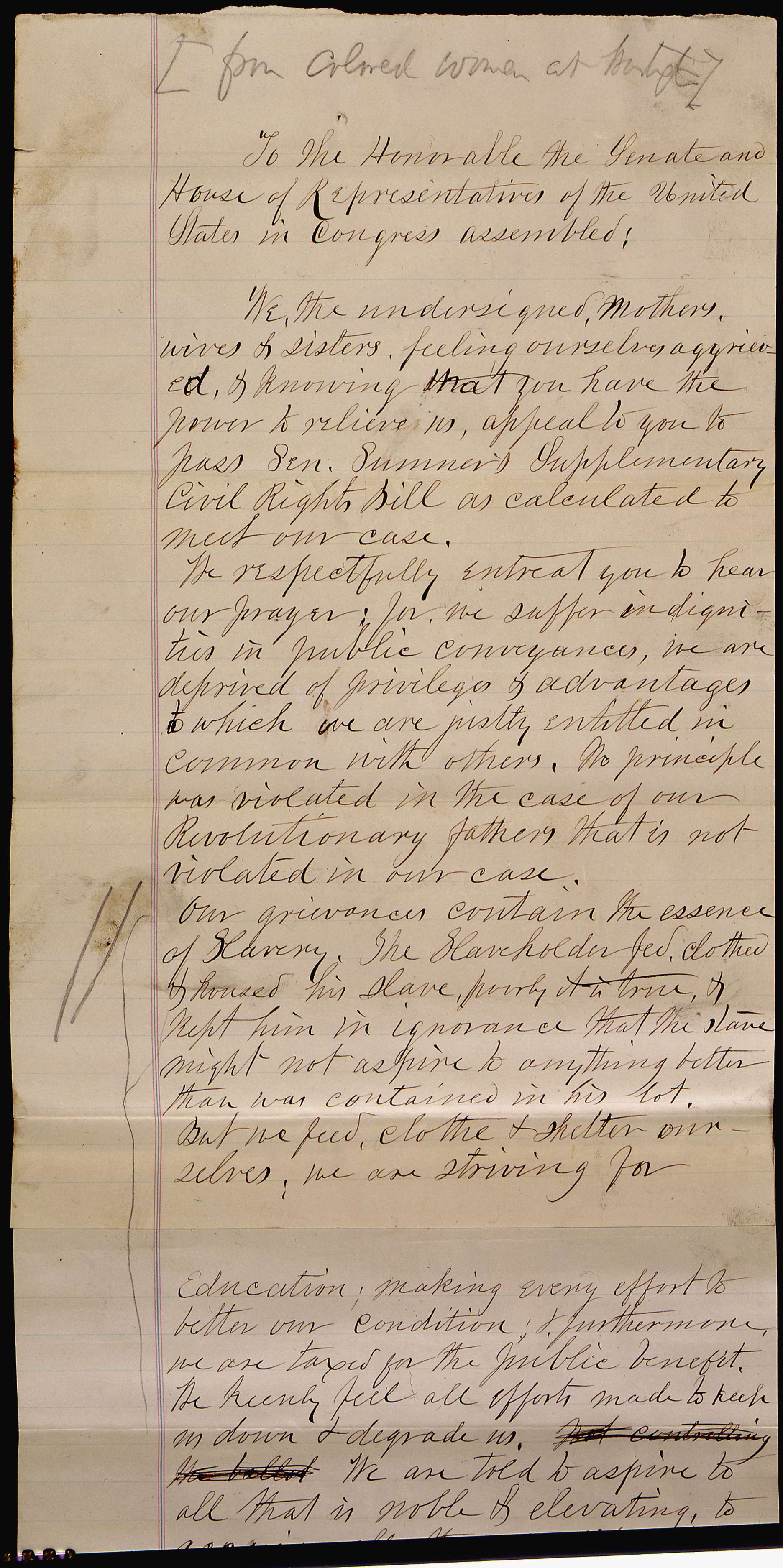
Petition from women of the District of Columbia asking for the passage of the Sumner Civil Rights Bill
Page 2

Document
Petition from Jefferson Township, Richland County, Ohio, to the Honorable G. W. Geddes Regarding Woman Suffrage
1884
Additional details from our exhibits and publications
This 1884 petition signed by 139 residents of Jefferson Township, Richland County, Ohio, requests that Ohio Congressman G.W. Geddes endorse—and influence fellow members to support—an amendment granting women the right to vote. Although the petition refers to the suffrage amendment as the 16th amendment, by 1920, when it eventually passed, the measure became the 19th amendment to the Constitution.
This primary source comes from the Records of the U.S. House of Representatives.
National Archives Identifier: 593459
Full Citation: Petition from Jefferson Township, Richland County, Ohio, to the Honorable G. W. Geddes Regarding Woman Suffrage; 1884; Records of the U.S. House of Representatives, . [Online Version, https://docsteach.org/documents/document/petition-from-jefferson-township-richland-county-ohio-to-the-honorable-g-w-geddes-regarding-woman-suffrage, April 30, 2024]Petition from Jefferson Township, Richland County, Ohio, to the Honorable G. W. Geddes Regarding Woman Suffrage
Page 1

Petition from Jefferson Township, Richland County, Ohio, to the Honorable G. W. Geddes Regarding Woman Suffrage
Page 2

Petition from Jefferson Township, Richland County, Ohio, to the Honorable G. W. Geddes Regarding Woman Suffrage
Page 3

Petition from Jefferson Township, Richland County, Ohio, to the Honorable G. W. Geddes Regarding Woman Suffrage
Page 4

Document
Memorial of Alice Wadsworth of the National Association Opposed to Woman Suffrage
12/11/1917
Formed in 1911, the National Association Opposed to Woman Suffrage had branches in 25 states by 1916. In this memorial to U.S. House of Representatives member Charles E. Fuller, President Alice H. Wadsworth and the association's women members argue against voting, citing the rights of individual states, the threat of feminism and socialism, and a warning that granting women the right to vote would be "an official endorsement of nagging as a national policy." Nonetheless, the 19th Amendment was ratified on August 26, 1920.
Transcript
National Association Opposed to Woman SuffragePresident, Mrs. JAS. W. WADSWORTH, Jr.
Washington, D. C.
Treasurer, Miss ANNE SQUIRE,
Washington, D. C.
Secretary, Mrs. ROBERT LANSING,
Washington, D. C.
[typewritten inside box]:
PLATFORM—THE NATIONAL ASSOCIATION OPPOSED TO WOMAN SUFFRAGE—Stands for HOME and NATIONAL DEFENSE against Woman Suffrage, Femininism and Socialism. For MAN-POWER in Government, believing that Democracy must be STRONG to be SAFE. For the PRESERVATION of the established foundations of the American Republic as a Model for the World. For the ENFORCEMENT of the CONSTITUTIONAL RIGHT of each State to settle the question of Woman Suffrage for Itself. For EFFICIENCY and Progress, without Waste and Duplication in Government. For the CONSERVATION of the best Womanhood of all conditions and stations of life. For the ultimate UNION of Women of all classes and creeds along NON-PARTISAN lines, so that the interests of Womanhood, Childhood and Civilization may be advanced FREE from the strife and division of politics, factions and parties. For the retention of the best IDEALS of the past, adapted to the advantages and opportunities given to women under modern conditions, so that the FUNDAMENTAL PRINCIPLES of Morality, of Patriotism and of World Progress may be more firmly established in the present and future generations.
[list of names on left side]:
Vice Presidents
Mrs. LOUIS A. FROTHINGHAM.
Boston, Mass.
Mrs. JOHN B. HERON,
Pittsburgh, Pa.
Miss ANNE MacILVAINE,
Trenton, N. J.
Mrs. HENRY B. THOMPSON,
Greenville, Del.
Mrs. N. C. YOUNG,
Fargo, N. Dak.
Mrs. EDWARD PORTER PECK,
Omaha, Neb.
Mrs. JOHN F. A. MERRILL,
Portland, Me.
Board of Directors
Mrs. JOHN BALCH,
Boston, Mass.
Mrs. HORACE BROCK,
Philadelphia, Pa.
Miss ALICE HILL CHITTENDEN
New York.
Mrs. ALBERTAS T. DUDLEY,
Exeter, N. H.
Mrs. C. H. DAVIS,
Washington, D. C.
Mrs. OSCAR LESER,
Baltimore, Md.
Mrs. J. B. GILFILLAN,
Minneapolis, Minn.
Mrs. ROWLAND G. HAZARD,
Peacedale, R. I.
Mrs. E. YARDE BREESE,
Trenton, N. J.
Mrs. H. F. LYSTER,
Detroit, Mich.
Mrs. DANIEL A. MARKHAM,
Hartford, Conn.
Mrs. DAVID CONANT,
Bradford, Vt.
Miss CAROLINE PATTERSON,
Macon, Ga.
Mrs. FRANCIS D. WILLIAMS,
Richmond, Va.
Mrs. H. E. TALBOTT,
Dayton, Ohio.
Miss N. W. BAKER,
Selma, Ala.
Mrs. F. A. MILLARD,
Burlington, Iowa.
Mrs. ERNEST JACKSON,
Dallas, S. Dak.
Mrs. JAMES B. WELLS,
Brownsville, Texas.
Mrs. D. C. GALLAHER,
Charleston, W. Va.
Mrs. C. E. ESTABROOK,
Milwaukee, Wis.
TELEPHONE MAIN 9854 44
1621 K STREET, WASHINGTON, D. C.
MISS MINNIE BRONSON, General Secretary.
December 11, 1917.
Hon. Chas. E. Fuller, M.C.,
Washington, D. C.
Dear Sir:
Your attention is invited to the following facts:
1. The proposed Federal suffrage amendment positively destroys the right of the people to vote on the question of woman suffrage, as provided for in their State Constitutions, and allows woman suffrage to be forced on unwilling States by the Legislatures of other States.
2. This proposal is a violation of the present Constitution of the United States, which provides that
"The powers not delegated to the United States by the Constitution, nor prohibited by it to the States, are reserved to the States respectively, or to the people."
3. The people, through their State Constitutions, ratified by popular vote, have reserved the right to adopt or withhold woman suffrage by popular vote.
4. This proposal asks you to rob the people of this right; to repudiate your party platform which recognizes the right of each State to settle this question for itself by popular vote.
Every principle of patriotism, every ideal of self-government, and your oath to defend the Constitution, urges you to vote against the attempt to obtain woman suffrage in spite of the expressed will of the people.
Moreover, this amendment, in time of war, would immediately open up a new nation wide suffrage campaign in forty-eight States to secure its ratification.
It would give suffragists and socialists the opportunity to annoy and pester every Legislator in the United States until a majority of the men in thirty-six Legislatures surrendered their judgment and principles to political threats and cajolery.
It would mean that no Legislature in the United States could meet without being surrounded by suffrage pickets.
It would be an official endorsement of nagging as a national policy.
It would give every radical woman the right to believe that she could get any law she wanted by "pestering" her City Council, her Legislature, her Congressman or her President - no matter how the people voted, nor what national crisis existed. And if feminism can be put through by pestering, regardless of the will of the people, so can pacifism, socialism and other isms.
Woman suffrage has been voted upon nineteen times in the last five years. Sixteen times it was defeated by popular vote.
Three times, (in Montana, Nevada and New York) it carried as the direct result of the increased socialist vote. This fact has been demonstrated mathematically.
Will you not defend the Constitution, your party platform and the rights of the people, rather than surrender to the futile threats and impotent dictation of the Woman Suffrage Machine and the Socialists, who are seeking this amendment precisely because they are not strong enough to carry woman suffrage in the majority of the States by popular vote?
Respectfully yours,
[signature of Alice H. Wadsworth]
President.
This primary source comes from the Records of the U.S. House of Representatives.
National Archives Identifier: 595295
Full Citation: Memorial of Alice Wadsworth of the National Association Opposed to Woman Suffrage; 12/11/1917; (HR 65A-H8.14); Petitions and Memorials, 1813 - 1968; Records of the U.S. House of Representatives, ; National Archives Building, Washington, DC. [Online Version, https://docsteach.org/documents/document/memorial-of-alice-wadsworth, April 30, 2024]Memorial of Alice Wadsworth of the National Association Opposed to Woman Suffrage
Page 1
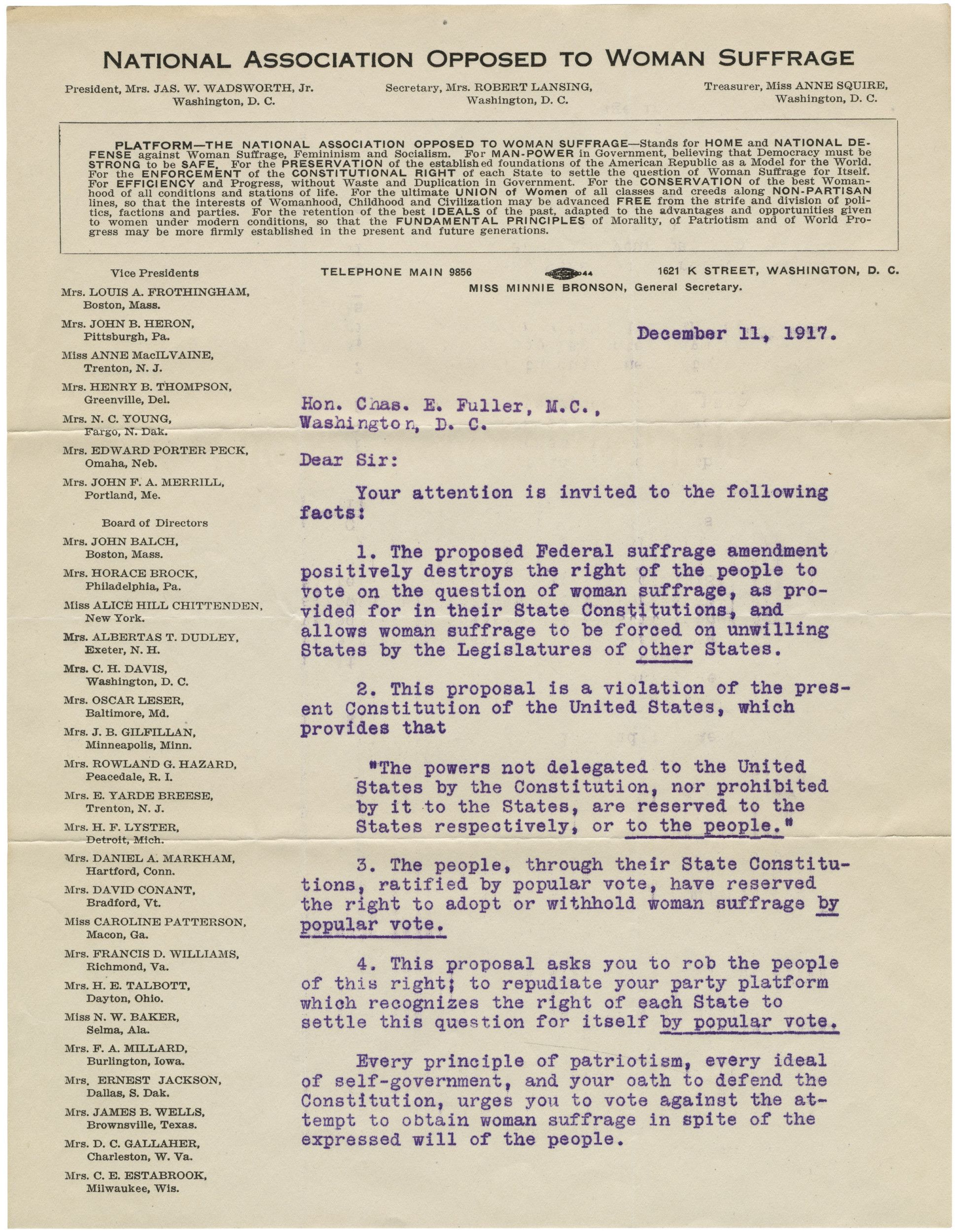
Memorial of Alice Wadsworth of the National Association Opposed to Woman Suffrage
Page 2

Memorial of Alice Wadsworth of the National Association Opposed to Woman Suffrage
Page 3
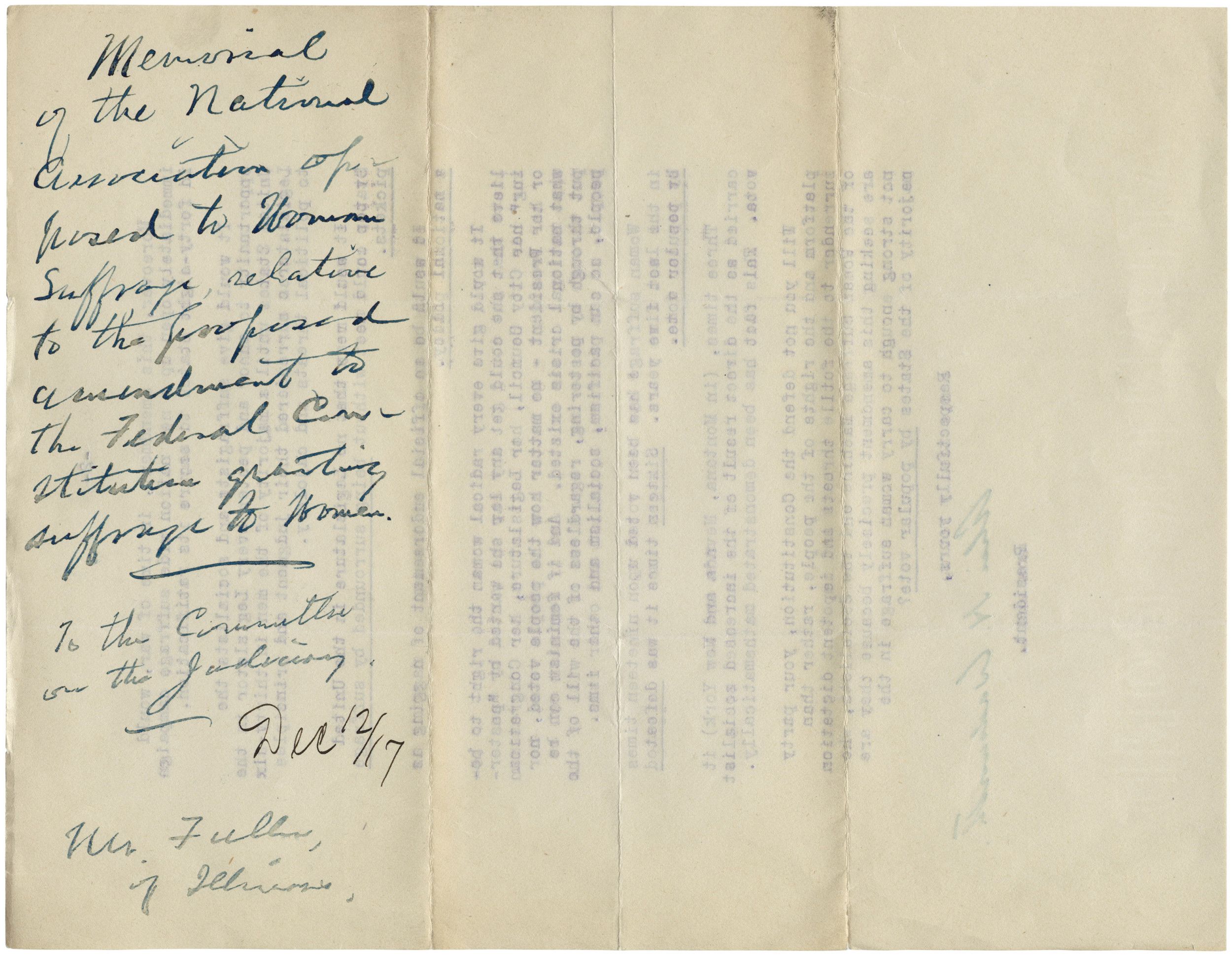
Document
Letter to the United States Congress from Elizabeth Cady Stanton and Susan B. Anthony and Others in Support of Women's Suffrage
12/1871
Elizabeth Cady Stanton, Susan B. Anthony, and four other prominent women's rights leaders addressed this petition to the Senate and House of Representatives. They asked Congress to enact a law giving women in the United States the right to vote. These women also asked to speak before both houses of Congress about this issue.
Stanton and Anthony had formed the National Woman Suffrage Association (NWSA) in May of 1869 – they opposed the 15th amendment (that granted black men the right to vote) because it excluded women. In the year following the ratification of the amendment, the NWSA sent this voting rights petition to Congress.
Vehement disagreement over supporting the 15th Amendment had resulted in a "schism" that split the women's suffrage movement into two new suffrage organizations focusing on different strategies to win women voting rights. One was the NWSA.
The other was the American Woman Suffrage Association (AWSA), founded in 1869 by Lucy Stone, Julia Ward Howe, and Thomas Wentworth Higginson. The AWSA supported the 15th Amendment and protested the confrontational tactics of the NWSA.
Stanton and Anthony had formed the National Woman Suffrage Association (NWSA) in May of 1869 – they opposed the 15th amendment (that granted black men the right to vote) because it excluded women. In the year following the ratification of the amendment, the NWSA sent this voting rights petition to Congress.
Vehement disagreement over supporting the 15th Amendment had resulted in a "schism" that split the women's suffrage movement into two new suffrage organizations focusing on different strategies to win women voting rights. One was the NWSA.
The other was the American Woman Suffrage Association (AWSA), founded in 1869 by Lucy Stone, Julia Ward Howe, and Thomas Wentworth Higginson. The AWSA supported the 15th Amendment and protested the confrontational tactics of the NWSA.
This primary source comes from the Records of the U.S. Senate.
National Archives Identifier: 1634184
Full Citation: Letter to the United States Congress from Elizabeth Cady Stanton and Susan B. Anthony and Others in Support of Women's Suffrage; 12/1871; Petition and Memorials, Resolutions of State Legislatures, and Related Documents which were Referred to the Committee on the Judiciary during the 42nd Congress; (SEN 42A-H11.4); Committee Papers, 1816 - 2011; Records of the U.S. Senate, ; National Archives Building, Washington, DC. [Online Version, https://docsteach.org/documents/document/congress-stanton-anthony, April 30, 2024]Letter to the United States Congress from Elizabeth Cady Stanton and Susan B. Anthony and Others in Support of Women's Suffrage
Page 1

Letter to the United States Congress from Elizabeth Cady Stanton and Susan B. Anthony and Others in Support of Women's Suffrage
Page 2
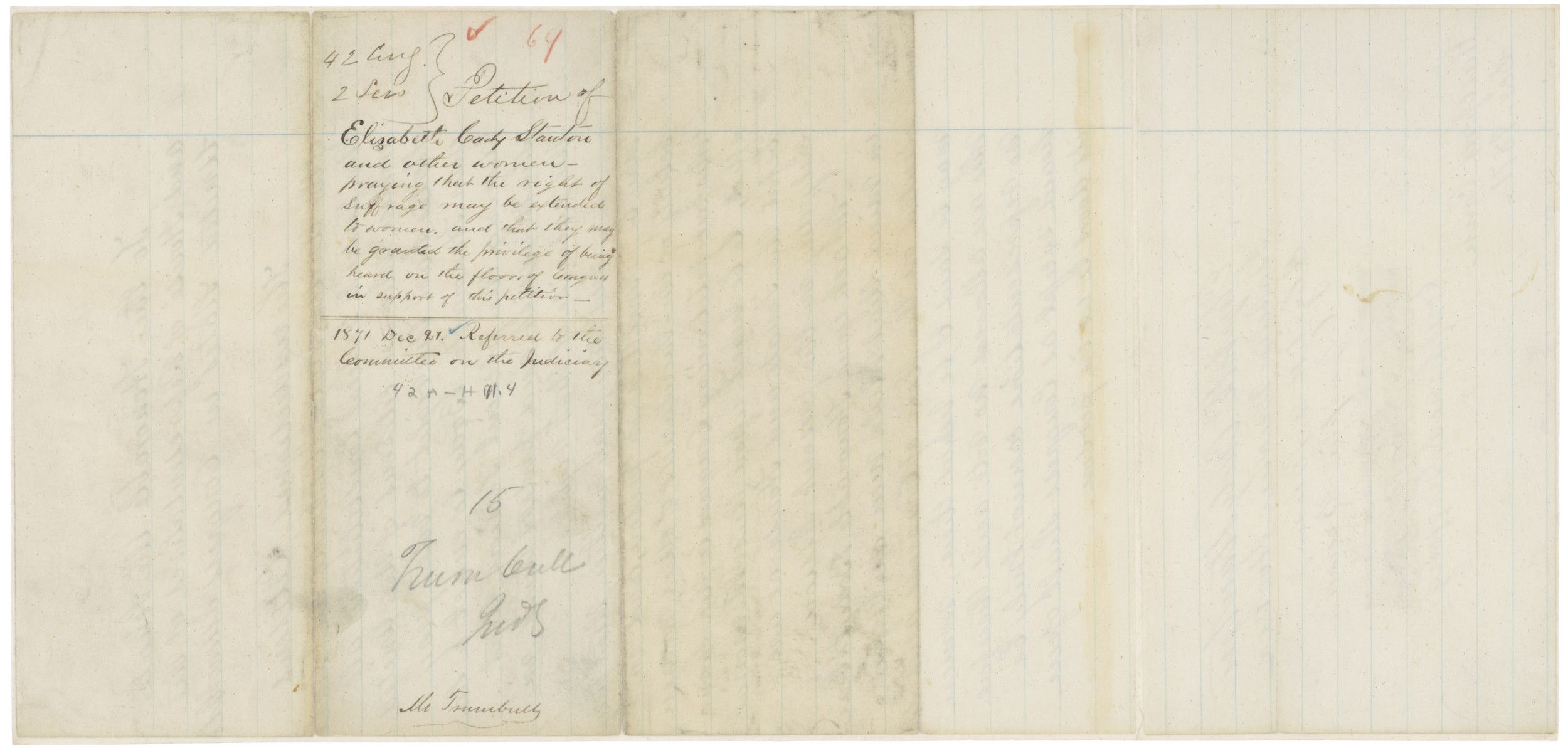
Document
Anti-Suffrage Postcards from Wallace Ellis to the Honorable Homer P. Snyder
1916
Wallace Ellis sent this postcard opposing the passage of the 19th Amendment to the Constitution to New York Congressman Homer P. Snyder. The amendment would grant women the right to vote on a national basis. Ellis’s opposition was in vain, as Congress passed a resolution proposing the amendment in 1919. After enough states ratified the amendment, Secretary of State Bainbridge Colby certified the ratification, and the 19th Amendment became part of the Constitution on August 26, 1920.
This primary source comes from the Records of the U.S. House of Representatives.
National Archives Identifier: 1633884
Full Citation: Anti-Suffrage Postcards from Wallace Ellis to the Honorable Homer P. Snyder; 1916; Records of the U.S. House of Representatives, . [Online Version, https://docsteach.org/documents/document/antisuffrage-postcard-ellis, April 30, 2024]Anti-Suffrage Postcards from Wallace Ellis to the Honorable Homer P. Snyder
Page 1
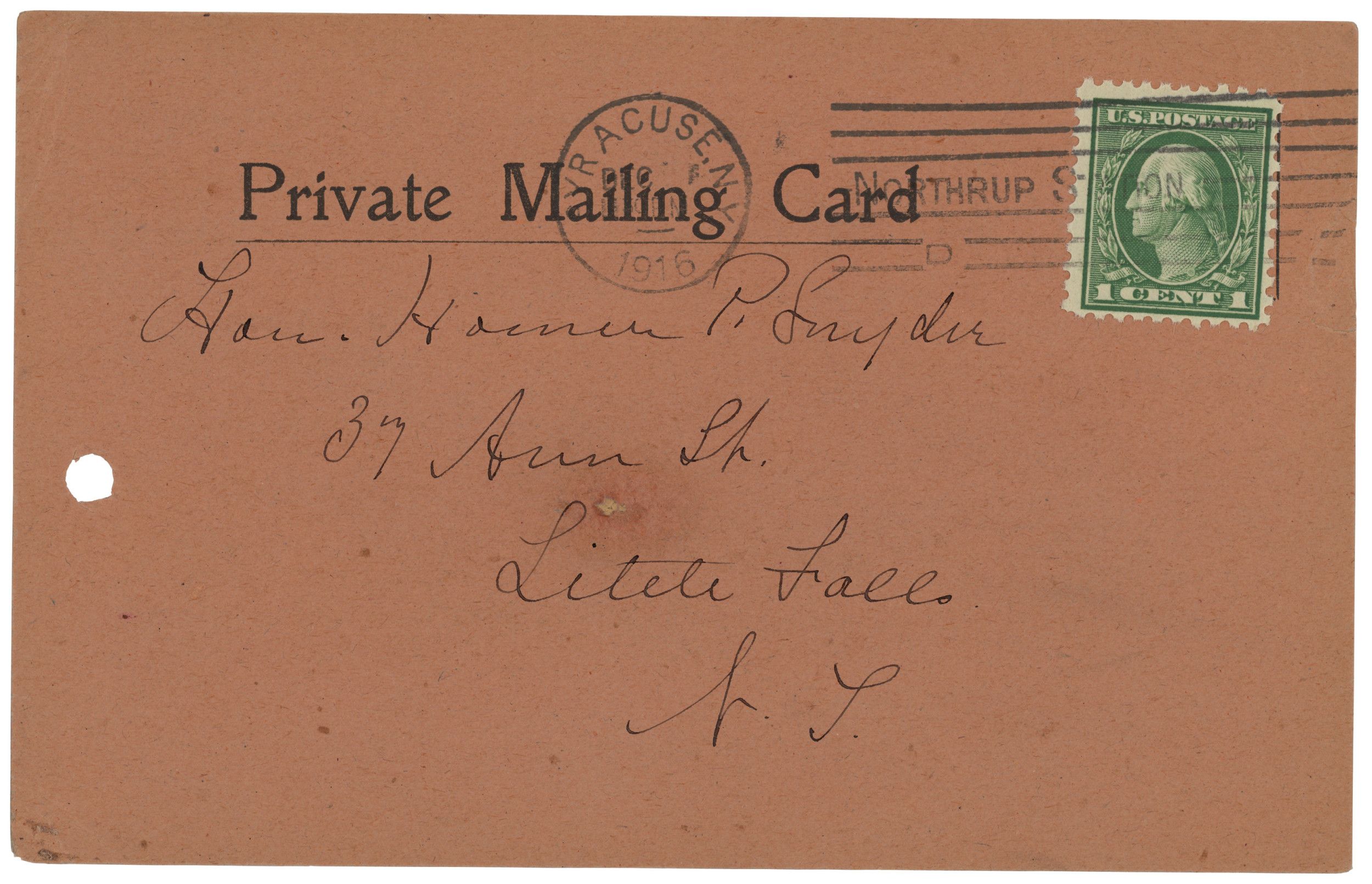
Anti-Suffrage Postcards from Wallace Ellis to the Honorable Homer P. Snyder
Page 2

Document
Form letter from E. Cady Stanton, Susan B. Anthony, and Lucy Stone asking friends to send petitions for women's suffrage to their representatives in Congress
12/26/1865
This form letter from Elizabeth Cady Stanton, Susan B. Anthony, and Lucy Stone asks friends to send petitions for women's suffrage to their representatives in Congress.
Transcript
New York, December 26, 1865.Dear Friend:
As the question of Suffrage is now agitating the public mind, it is the hour for Woman to make her demand.
Propositions have already been made on the floor of Congress to so amend the Constitution as to exclude Women from a voice in the Government.* As this would be to turn the wheels of legislation backward, let the Women of the Nation now unitedly protest against such a desecration of the Constitution, and petition for that right which is at the foundation of all Government, the right of representation.
Send your petition, when signed, to your representatives in Congress, at your earliest convenience.
Address all communications to
Standard Office, 48 Beekman St., New York.
In behalf of the National W. R. Com.
E. Cady Stanton,
S.B. Anthony,
Lucy Stone.
*See Bill of Mr. Jenckes, of Rhode Island.
This primary source comes from the Records of the U.S. House of Representatives.
National Archives Identifier: 306686
Full Citation: Form letter from E. Cady Stanton, Susan B. Anthony, and Lucy Stone asking friends to send petitions for women's suffrage to their representatives in Congress; 12/26/1865; (HR 39A-H14.9); Petitions and Memorials Referred to the Committee on the Judiciary, 6/3/1813 - 1998; Records of the U.S. House of Representatives, ; National Archives Building, Washington, DC. [Online Version, https://docsteach.org/documents/document/form-letter-stanton-anthony-stone, April 30, 2024]Form letter from E. Cady Stanton, Susan B. Anthony, and Lucy Stone asking friends to send petitions for women's suffrage to their representatives in Congress
Page 1

Document
Suffragette banner. One of the banners, the women who picketed the White House...
ca. 1917 - 1918
The original caption for this photograph reads: Suffragette banner. One of the banners the women who picketed the White House and Capitol carried.
Frustrated with President Woodrow Wilson’s inaction on woman suffrage, the National Woman’s Party picketed the White House. The protesters demonstrated for nearly 30 months until Congress passed a joint resolution proposing a 19th amendment on June 4, 1919.
Frustrated with President Woodrow Wilson’s inaction on woman suffrage, the National Woman’s Party picketed the White House. The protesters demonstrated for nearly 30 months until Congress passed a joint resolution proposing a 19th amendment on June 4, 1919.
This primary source comes from the Records of the War Department General and Special Staffs.
National Archives Identifier: 533769
Full Citation: Photograph 165-WW-(600A)5; Suffragette banner. One of the banners, the women who picketed the White House...; ca. 1917 - 1918; American Unofficial Collection of World War I Photographs, 1917 - 1918; Records of the War Department General and Special Staffs, ; National Archives at College Park, College Park, MD. [Online Version, https://docsteach.org/documents/document/kaiser-wilson-suffragette, April 30, 2024]Suffragette banner. One of the banners, the women who picketed the White House...
Page 1

Document
Women Taking Place of Men on Great Northern Railway at Great Falls, Montana
ca. 1918
As more male workers joined the armed forces during World War I, women like these railroad employees in Great Falls, Montana, were encouraged to enter occupations that had traditionally been done by men. Few industrial fields showed permanent increases in female workers after the war. Most women workers moved up only temporarily from lower-paying jobs to which they soon returned after the war ended.
This primary source comes from the Records of the War Department General and Special Staffs.
National Archives Identifier: 533760
Full Citation: Photograph 165-WW-595D(14); Women Taking Place of Men on Great Northern Railway at Great Falls, Montana; ca. 1918; American Unofficial Collection of World War I Photographs, 1917 - 1918; Records of the War Department General and Special Staffs, ; National Archives at College Park, College Park, MD. [Online Version, https://docsteach.org/documents/document/women-great-northern-railway, April 30, 2024]Women Taking Place of Men on Great Northern Railway at Great Falls, Montana
Page 1
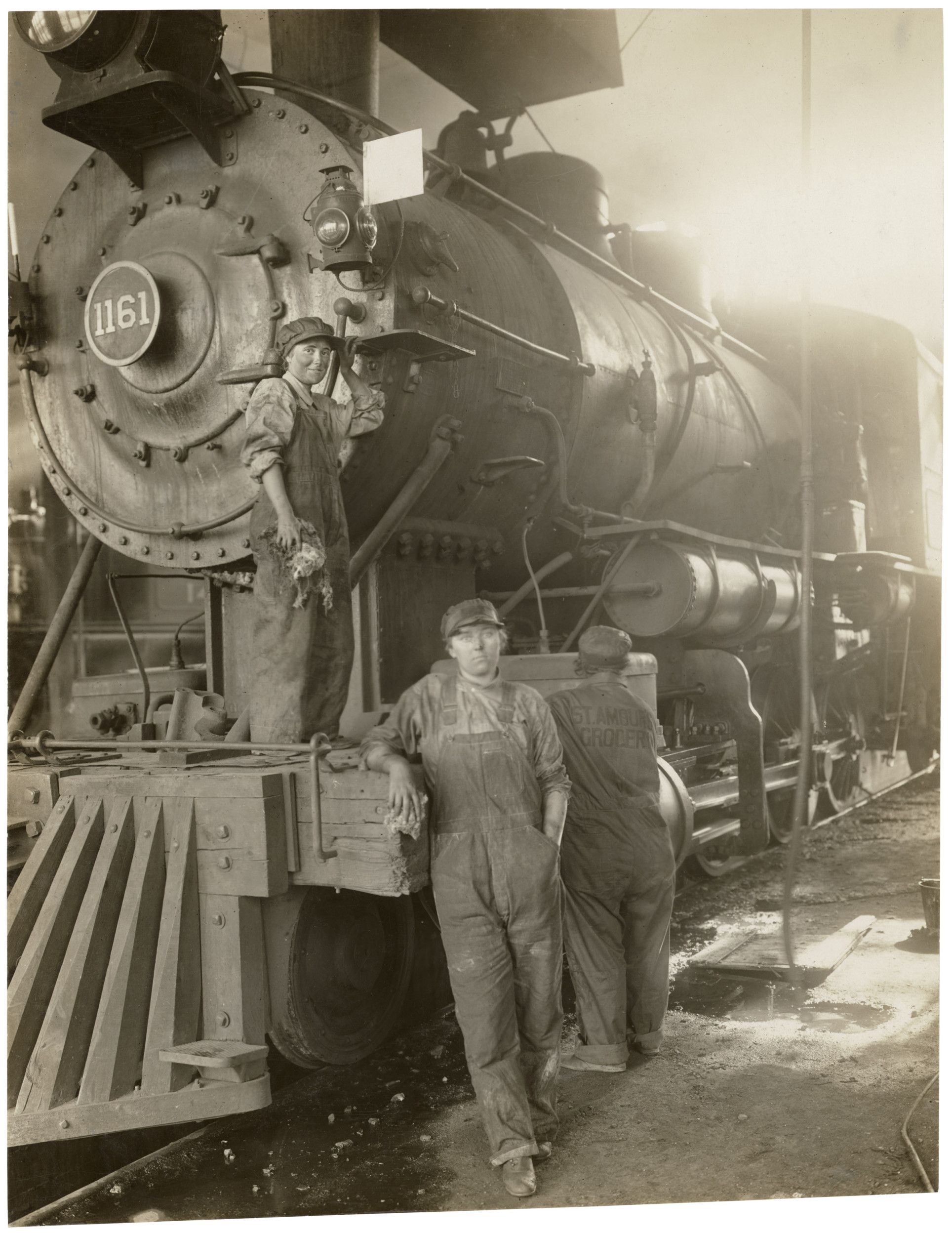
Document
'The Nonsense of It,' A Printed Pamphlet Arguing for Women's Suffrage
12/26/1865
This printed pamphlet arguing for women's suffrage, written by abolitionist Thomas Wentworth Higgins, circulated in 1865. It presented a rebuttal to common arguments against suffrage and perceptions that defined women’s roles and behavior during the 19th century. Among these arguments were such concepts as women are “sufficiently represented already,” or “entirely distinct from men,” or “silly creatures,” or that “it would lead to such divisions in families.”
Transcript
THE NONSENSE OF IT."It would never do for women to vote, it would lead to such divisions in families." But political divisions do not, after all, make men quarrel half so much as religious divisions; and if you allow wives to do their own thinking in religion, why not in politics? Besides, nothing makes a man so coaxing and persuasive as when he tries to induce his neighbor to vote "our ticket." Husbands who are boors all the rest of the year would become patterns of politeness for a month before election day,—if the wives only had a vote!
"The polls are not decent places for women, at present." Then she is certainly needed there to make them decent. Literature was not decent, nor the dinner table, till she was admitted to them, on equal terms. But already, throughout most parts of the country, the ballot-box is as quiet a place to go to as the Post-office; and where it is not so, the presence of one woman would be worth a dozen policemen.
"Politics are necessarily corrupting." Then why not advise good men, as well as good women, to quit voting?
"I should not wish to hear my wife speak in town meeting." I should think not, unless she spoke more to the point than the average of men. Perhaps she would; no telling till she tries. And you are willing to pay a high price occasionally to hear somebody's else wife sing in public—and if it is proper for a woman to sing nonsense before an audience, why not to speak sense?
"Woman is sufficiently represented already, through her influence on men." How is it then that the whole legislation of Christendom, in regard to her, was "a disgrace to any heathen nation," till the Woman's Rights Conventions began to call attention to it, ten years ago?
"Women are entirely distinct from men, altogether unlike, quite a different order of beings." Are they indeed? Then, if they are so distinct, how can men represent them, make laws for them, administer their rights, judge them in court, spend their tax-money? If they are the same with men, they have the same rights; if they are distinct, they have a right to a distinct representation, distinct laws, courts, property, and all the rest. Arrange it as you please, it comes to the same thing.
"A woman who takes proper care of her household, has no time to know anything about politics." Why not say, "a man who properly supports his household, has no time to know anything about politics?" Show me the husband who does not assure his wife that his day's work is harder than her's. How absurd, then, to suppose that he has time to read the newspaper every day, and step round to the ballot-box once a year—and she has not?
"Women, after all, are silly creatures." No doubt they are, often enough. As the old lady says in a late English novel, "God Almighty made some of them foolish, to match the men." And the men have done their best to turn the heads of others, who were no fools by nature. But it is the theory of democracy that every man has a right to express his own folly at the ballot-box, if he will—and in time, perhaps, learn more sense by so doing. And why not every woman too?
The amount of it all is, that woman must be enfranchised; it is a mere question of time. All attempts to evade this, end in inconsistency and nonsense. Either she must be a slave or an equal; there is no middle ground. Admit, in the slightest degree, her right to education or to property, and she must have the right of suffrage in order to protect the property and use the education. And there are no objections to this, except such as would equally hold against the whole theory of democratic government.
This primary source comes from the Records of the U.S. House of Representatives.
National Archives Identifier: 306685
Full Citation: 'The Nonsense of It,' A Printed Pamphlet Arguing for Women's Suffrage; 12/26/1865; Petitions and Memorials Referred to the Committee on the Judiciary, 6/3/1813 - 1998; Records of the U.S. House of Representatives, ; National Archives Building, Washington, DC. [Online Version, https://docsteach.org/documents/document/nonsense-of-it, April 30, 2024]'The Nonsense of It,' A Printed Pamphlet Arguing for Women's Suffrage
Page 1

'The Nonsense of It,' A Printed Pamphlet Arguing for Women's Suffrage
Page 2

Document
Letter from Thomas A. Johnstone to George Taylor
6/8/1943
This is a letter dated June 8, 1943 from Thomas A. Johnstone, International Representative of the United Automobile, Aircraft, and Agricultural Implement Workers of American (UAW-CIO), to George Taylor, Vice Chairman of the National War Labor Board relating to women's pay.
Additional details from our exhibits and publications
Thomas Johnstone, representative of the United Automobile, Aircraft, Agriculture Implement Workers of America, wrote this letter to the National War Labor Board stating the union's opinion on the question of women's pay rates.
This primary source comes from the Records of the National War Labor Board (World War II).
National Archives Identifier: 595878
Full Citation: Letter from Thomas A. Johnstone to George Taylor; 6/8/1943; Records of the National War Labor Board (World War II), . [Online Version, https://docsteach.org/documents/document/letter-from-thomas-a-johnstone-to-george-taylor, April 30, 2024]Letter from Thomas A. Johnstone to George Taylor
Page 1

Letter from Thomas A. Johnstone to George Taylor
Page 2

Document
We Can Do It!
ca. 1942 - 1943
This now iconic poster was designed by artist J. Howard Miller and commissioned by the Westinghouse Electric and Manufacturing Company. Though today the poster is often identified as "Rosie the Riveter," the "We Can Do It" poster was originally displayed for just two weeks in 1943 on the walls inside of Westinghouse plants. It was one of many posters that were meant to keep the American workforce motivated throughout World War II.
In 1944, the War Production Board offered a collection of over 1,500 posters, including "We Can Do It" to the National Archives. Many years later, in the early 1980s, the poster reeemerged into the public eye and has since been adopted by many as a symbol of female empowerment, especially embodying the WWII ideal of "Rosie the Riveter."
In 1944, the War Production Board offered a collection of over 1,500 posters, including "We Can Do It" to the National Archives. Many years later, in the early 1980s, the poster reeemerged into the public eye and has since been adopted by many as a symbol of female empowerment, especially embodying the WWII ideal of "Rosie the Riveter."
This primary source comes from the Records of the War Production Board.
National Archives Identifier: 535413
Full Citation: Poster 179-WP-1563; We Can Do It!; ca. 1942 - 1943; War Production Board, 1942 - 1943; Records of the War Production Board, ; National Archives at College Park, College Park, MD. [Online Version, https://docsteach.org/documents/document/we-can-do-it, April 30, 2024]We Can Do It!
Page 1

Document
Photograph of a Portrait of a Mother and Daughter
1890
Additional details from our exhibits and publications
These portraits of an unknown young girl and her mother, taken about 1890 by the Treasury Department, are from a series of photographs of Government buildings, officials, and workers and their families.
This primary source comes from the Records of the Public Buildings Service.
National Archives Identifier: 596267
Full Citation: Photograph of a Portrait of a Mother and Daughter; 1890; Records of the Public Buildings Service, . [Online Version, https://docsteach.org/documents/document/photograph-of-a-portrait-of-a-mother-and-daughter, April 30, 2024]Photograph of a Portrait of a Mother and Daughter
Page 1

Document
Photograph of Nurses Being Instructed on the Use of Respirator for a Polio Patient
5/23/1958
The photograph shows nurses being trained on the use of a respirator, or an “iron lung,” for a polio patient.
First invented in 1927 by Philip Drinker and Louis Agassiz Shaw and refined by John Emerson in 1931, the respirator helped polio patients breathe if their chest muscles became paralyzed during the illness.
First invented in 1927 by Philip Drinker and Louis Agassiz Shaw and refined by John Emerson in 1931, the respirator helped polio patients breathe if their chest muscles became paralyzed during the illness.
This primary source comes from the General Records of the Department of Labor.
National Archives Identifier: 1633453
Full Citation: 174-G-30-1; Photograph of Nurses Being Instructed on the Use of Respirator for a Polio Patient; 5/23/1958; Photographic Prints of Occupations, Labor Activities, and Personalities, 1940–1970; General Records of the Department of Labor, ; National Archives at College Park, College Park, MD. [Online Version, https://docsteach.org/documents/document/photograph-of-nurses-being-instructed-on-the-use-of-respirator-for-a-polio-patient, April 30, 2024]Photograph of Nurses Being Instructed on the Use of Respirator for a Polio Patient
Page 1

Document
Sandra Day O'Connor Being Sworn in as Supreme Court Justice by Chief Justice Warren Burger, Her Husband John O'Connor Looks On
9/25/1981
Sandra Day O’Connor, the first woman to be appointed to the U.S. Supreme Court, was sworn in on September 25, 1981. Chief Justice Warren Burger administered the oath as Justice O’Connor’s husband, John, looked on. She served 24 years on the Supreme Court before her retirement in 2006.
O’Connor’s influence on the court was immense, as she often acted as a swing vote on key decisions. Some of the notable cases that O’Connor worked on include Bush v. Gore (2000), which confirmed George W. Bush as President, and Planned Parenthood v. Casey (1992), which helped uphold the Roe v. Wade (1973) decision that legalized abortion. And she was the deciding vote on a number of anti-discrimination and civil rights related cases.
Her time on the court also showcased her resilience, as she fought breast cancer. After being diagnosed, there was speculation that she would retire from the court, but O’Connor continued her service. Even though she needed surgery and received chemotherapy, she did not miss any oral arguments and continued her duties as a Justice.
O’Connor was the lone female Supreme Court Justice for most of her tenure, until Justice Ginsburg joined her in 1993. However, O’Connor did not want her gender to be a confining factor of her identity as a strong and effective Justice. “The power I exert on the court depends on the power of my arguments, not on my gender,” Sandra Day O’Connor famously said.
O’Connor’s influence on the court was immense, as she often acted as a swing vote on key decisions. Some of the notable cases that O’Connor worked on include Bush v. Gore (2000), which confirmed George W. Bush as President, and Planned Parenthood v. Casey (1992), which helped uphold the Roe v. Wade (1973) decision that legalized abortion. And she was the deciding vote on a number of anti-discrimination and civil rights related cases.
Her time on the court also showcased her resilience, as she fought breast cancer. After being diagnosed, there was speculation that she would retire from the court, but O’Connor continued her service. Even though she needed surgery and received chemotherapy, she did not miss any oral arguments and continued her duties as a Justice.
O’Connor was the lone female Supreme Court Justice for most of her tenure, until Justice Ginsburg joined her in 1993. However, O’Connor did not want her gender to be a confining factor of her identity as a strong and effective Justice. “The power I exert on the court depends on the power of my arguments, not on my gender,” Sandra Day O’Connor famously said.
This primary source comes from the Collection RR-WHPO: White House Photographic Collection.
National Archives Identifier: 276563289
Full Citation: C4121-11a; Sandra Day O'Connor Being Sworn in as Supreme Court Justice by Chief Justice Warren Burger, Her Husband John O'Connor Looks On; 9/25/1981; Reagan White House Photographs, 1/20/1981 - 1/20/1989; Collection RR-WHPO: White House Photographic Collection, ; Ronald Reagan Library, Simi Valley, CA. [Online Version, https://docsteach.org/documents/document/oconnor-sworn-in, April 30, 2024]Sandra Day O'Connor Being Sworn in as Supreme Court Justice by Chief Justice Warren Burger, Her Husband John O'Connor Looks On
Page 1
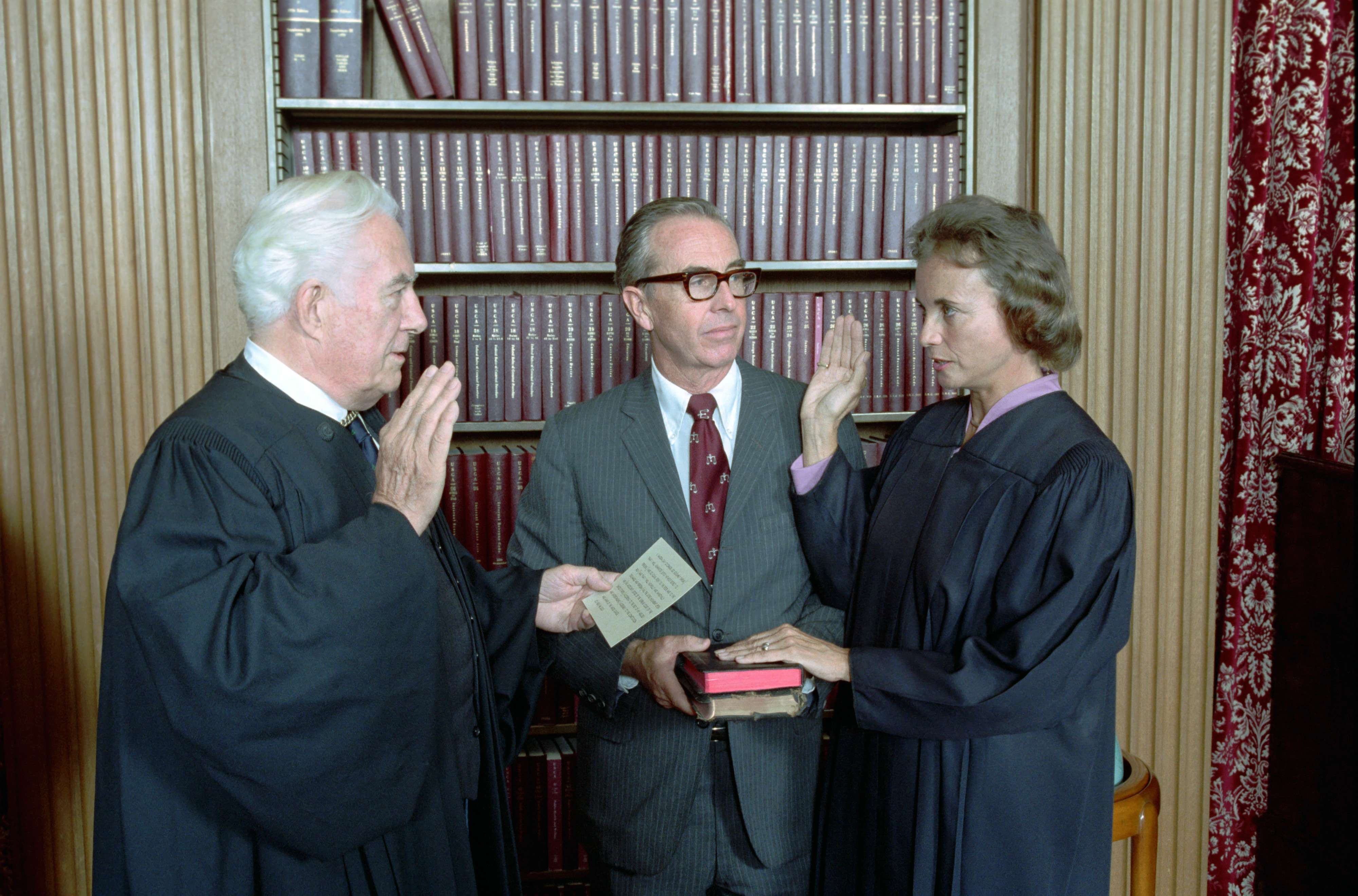
Document
Letter to the Committee on the Judiciary Regarding Suffrage for 18-Year Olds
12/23/1970
Additional details from our exhibits and publications
George M. Montross of Detroit wrote to Congressman Emanuel Celler, Chairman of the House Judiciary Committee, in opposition to granting the vote to 18-year-olds. He argued that only the states, not the Federal Government, had the power to determine qualifications for voting.
This primary source comes from the Records of the U.S. House of Representatives.
National Archives Identifier: 1634195
Full Citation: Letter to the Committee on the Judiciary Regarding Suffrage for 18-Year Olds; 12/23/1970; Records of the U.S. House of Representatives, . [Online Version, https://docsteach.org/documents/document/letter-to-the-committee-on-the-judiciary-regarding-suffrage-for-18year-olds, April 30, 2024]Letter to the Committee on the Judiciary Regarding Suffrage for 18-Year Olds
Page 1

